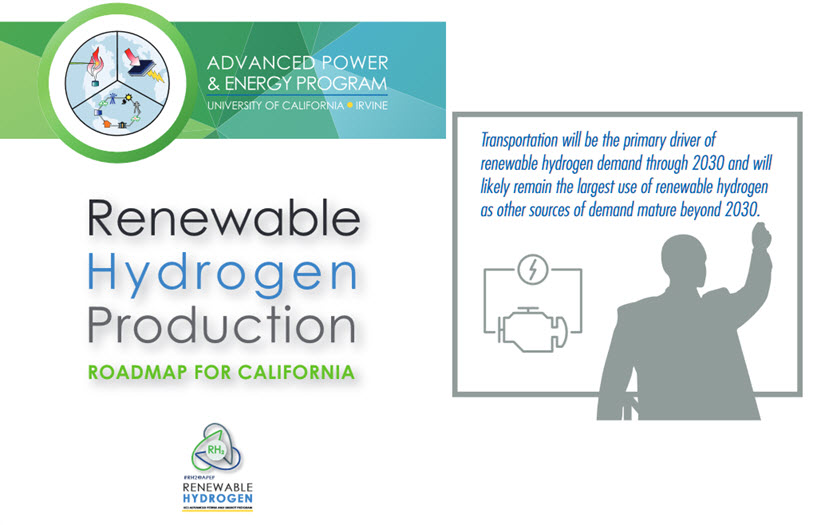
Roadmap provides guidance on actions needed to launch and scale the California renewable hydrogen production sector to advance state policy goals
Irvine, Calif. — The Advanced Power and Energy Program (APEP) recently completed a roadmap for the scaling and build-out of the renewable hydrogen, or RH2, production sector in California to serve a broad range of applications in the energy and transportation sectors.
RH2 can be a key foundation in decarbonization strategies, serving as a flexible source of renewable energy available on demand and storable in massive quantities.
“The roadmap, which is grounded in extensive research, stakeholder input, and quantitative analysis, projects that California can achieve a self-sustaining renewable hydrogen sector by the mid 2020’s, meaning one which grows without special subsidies,” said the report’s principal author Dr. Jeff Reed, APEP chief scientist for renewable fuels and energy storage.
The effort focused on extracting insights from the first set of renewable hydrogen production facilities under development in California to establish current cost and system performance levels and then projecting forward through 2050.
In addition, the growth in demand for renewable hydrogen was forecast for all forms of transportation, energy storage, heating applications, refining and fertilizer production. The roadmap provides significant detail through the 2020s and a higher-level outlook in five-year increments through 2050.
Renewable hydrogen can be produced in a variety of ways. The three primary pathways considered in the roadmap were water splitting via electrolysis powered by renewable electricity, gasification of woody biomass, and anaerobic digestion of high-moisture-content organic material to produce biomethane followed by steam methane reforming.
Establishing the current cost of producing renewable hydrogen and forecasting costs out to 2050 was a key part of the RH2 production roadmap analysis.
The net result of the analysis is that RH2 produced by either electrolysis or gasification can reach a cost point below $2 per kilogram by 2030 and the full dispensed cost of hydrogen for fueling vehicles can reach a cost point of under $5 per kilogram over the long term.
“Renewable hydrogen can be an important, in fact critical, part of a broad decarbonization strategy for California and the world,” said Scott Samuelsen, APEP director and UCI professor of mechanical & aerospace engineering. The roadmap analysis confirms the critical role that hydrogen can play as a foundation for sustainability, and it affirms California’s position as a global leader in advancing hydrogen solutions.”
APEP researchers are pursuing a broad range of research on the role of hydrogen in achieving a 100-percent renewable electric grid and transportation sector. The siting analysis in the renewable hydrogen roadmap builds upon APEP’s foundational work in developing the STREET planning tool that was adopted by the state of California for the optimal siting analysis for the first two phases of hydrogen vehicle fueling stations build-out in the state.
California Roadmap for Generation of Renewable Hydrogen (PDF)
https://bit.ly/RH2roadmap
About the Advanced Power and Energy Program:
APEP addresses the broad utilization of energy resources and the emerging connection of electric power generation, infrastructure, transportation, water resources and the environment. It seeks to develop, promote and deploy increasingly efficient and environmentally sustainable power production and energy conversion worldwide, with a focus on the creation and sharing of new knowledge through fundamental and applied research, education and outreach.
About the University of California, Irvine (UCI):
Founded in 1965, UCI is the youngest member of the prestigious Association of American Universities. The campus has produced three Nobel laureates and is known for its academic achievement, premier research, innovation and anteater mascot. Led by Chancellor Howard Gillman, UCI has more than 30,000 students and offers 192 degree programs. It’s located in one of the world’s safest and most economically vibrant communities and is Orange County’s second-largest employer, contributing $5 billion annually to the local economy. For more on UCI, visit www.uci.edu.
Read the most up to date Fuel Cell and Hydrogen Industry news at FuelCellsWorks




